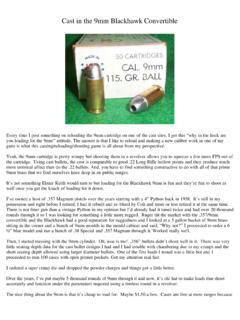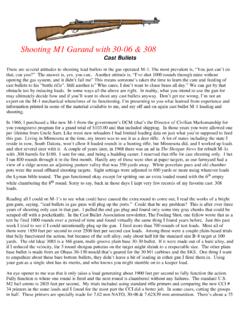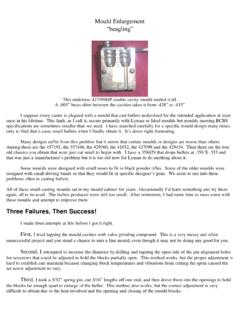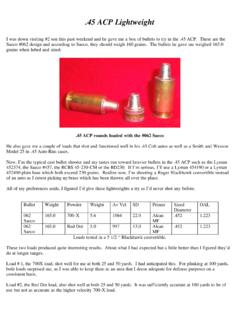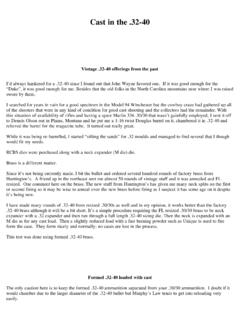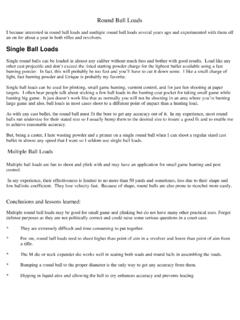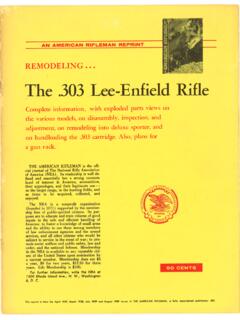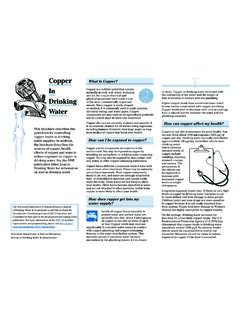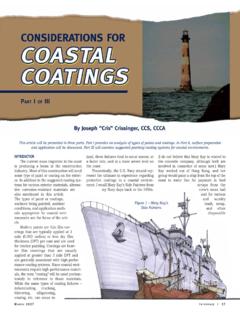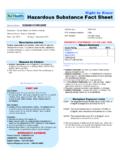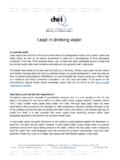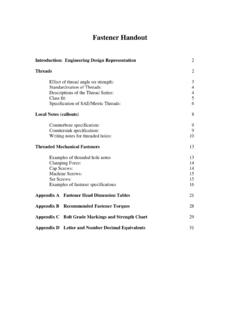Transcription of Cast in the - Castpics
1 cast in the .30 Carbine Pistol I was really hoping to avoid going back and messing with the .30 Carbine cartridge any more as I d already worked onthe .30 M1 Carbine for about 6 months this winter and did extensive work with Paco Kelley s Long Range Carbineload already but with a bunch of bullets already cast , all the tools and dies and a Ruger Blackhawk .30 Carbine onhand, I ll attempt to work a bit on loads I ve been using for several years and see if I can improve on them any. In addition, I have three new bullets acquired for use in my Ruger .32 H & R Magnum that I ve wanted to try in Carbine since downsizing now allows us to do this. A lot of folks have never liked the .30 Carbine Blackhawk. Many people buy one and shoot either GI ball ammo in itor factory ammo and the result is that it s noisy but is accurate. Only a small percentage of people ever attempt to loadcast bullets in it and at that endeavor, very few are successful. The .30 Carbine round is hot.
2 In fact it s very hot pressure wise and I make no attempt at reaching the full potentialwith cast loads in it. I m normally satisfied with 1200-1400 feet per second loads and let it go at that. If you desirefaster loads, grab an appropriately designed bullet with a gas check and be my guest and open the throttle. I ll justputz along at more sedate velocities. First off, the .30 Carbine round is hard to load for. In a Blackhawk, the case length must be just right and you musthave a minimum of a taper crimp. If the case length is too long, you ll tie up the gun. If the crimp is too much, thecartridge will start to drop too far into the cylinder and you ll experience misfires or excessive headspace. So the firstthing to do is find some brass and trim it to the correct dimensions. This sound easy, but much of the GI brass isalready at or thereabouts. Might not make any difference in a carbine but it does in a Ruger. The second thing to realize about the.
3 30 Carbine in a pistol is that it is a pistol. Data for the .30 Carbine in the carbinemight be safe but it s only a revolver so you don t need to be constrained so much by powder type as you re notworried about the action functioning as you do with the carbine. You can load mid range loads for punching paper aswell as the blue streakers for whatever purpose you intend them for. I ve noticed a trend of the loading manuals to regurgitate the data for the carbine for the pistol. Just be aware that you can use almost any of the pistol powder forthese loads. Now, if you re loading for a AMT, things may be a bit different and go pretty close to the data for thecarbine dependent on the spring in your particular gun as far as functioning goes. I personally do a lot of plinking with mine at 100 yards. At those ranges, 1100-1200 FPS loads shoot just fine for whatI m doing and are pleasant to shoot. Bullets I have a bunch of moulds that are suitable for use in the .30 Carbine Blackhawk.
4 Too many in fact to attempt to gothrough all of them here with all of the load combinations you could dream up. In my opinion (and you know about those), there are only several bullets that should be used in the .30 Carbinerevolver. A bullet for small game, field and general-purpose loads in the .30 Carbine should weigh at least 110 grains. It should be of semi-wad cutter design or round flat nose design (my opinion). This boils the selection down to three bullets; the Lyman/Ideal 3118/311008, the Lyman 31133 hollow point or theLyman Ideal 311316, which is a gas check design. The 311316 shoots well in the .30 Carbine but at the velocitieswe re talking here, the gas check is a wasted expense. Besides, the 311316 is a discontinued mould and available onlyby chance. The 31133 is also a collector s item and demands collector s you can find one. I d originally thought that maybe the Lyman 313631 and RCBS 32-98-SWC would be appropriate. I loaded thefollowing test loads using the Lyman 313631 plain base hollow point and the 32-98-SWC RCBS and test fired them.
5 Test loads using the Lyman 313631 PB HP and the RCBS 32-98-SWCB ulletWeight Powder Weight Primer AverageVelocityStandardDeviationSizedDia meterOverallLengthComments313631PB @ 100 Yards313631PB @ 100 Yards313631PB @ 100 Yards313631PB @ 100 Yards Both bullets were a disappointment to me. Although both are accurate enough for 100 yard plinking, the weights ofthe bullets seemed too light. I was barely able to determine impact at 100 yards and I m use to shooting heavier bulletsand seeing something happen on the terminal end. These two bullets posses the accuracy desired but due to the weight,should be left to the 32 Magnum. In the table below, I ve listed the bullet moulds I have on hand. Any of these can be loaded in the .30 Carbine pistols. I just believe that we need a heavier bullet of the proper design to get the performance that we re looking for. For this article, I ll use the old reliable 3118 as it s still available and so far, I ve found no better bullet in this caliberin the pistol.
6 Since it weighs in at around 120 grains, any lighter bullets will shoot with this data and the data can becut for anything heavier. Exceptions to this rule are the wad cutter bullets, the 313492 and the 32-98-WC which requires the data to be cut backdrastically due to the deep seating depth of these bullets. Also, the extremely heavies like the 311440 and the 30-150-FN should be loaded only with instructions in the article, Paco s Long Range Carbine Load. Bullet NumberWeight Style3118 (3) HP(3) HP GC302 Saeco GC311359 GC311465(4) GC311465 HP(4) GC313492(1) (1) GC313631 PB(1) PB HP(1) (1) (1) (2) (2) GC311440 HP(2) GC Note 1 The bullets with a (1) by them will normally run about .313 as cast and will need to be downsized to . Normally, this is not a problem and can be done in a normal sizing die and good accuracy will result. Thesebullets are normally designed for the .32 H & R Magnum but can be readily used in the .30 Carbine.
7 Note 2 The bullets with a (2) by them are bullets which are normally intended for rifles. Under special conditionsthey can be loaded and fired in a .30 Carbine Ruger. See the article on Paco s Long Range Carbine Load elsewhere inthese articles. Note 3 To eliminate any confusion about mould numbers. I have two different moulds in this design. One is anolder Ideal 3118 and the other one is a double cavity Lyman numbered 311008. One cavity of this one is a hollowpoint. Note 4 The 311465 and 311465 HP will not allow normal seating when sized to .310 . I overcame this by nose firstsizing the fist band to .309 . This allows the bullet to be seated out to the point where seating depth doesn t affectpressures so much. In addition to these designs that I have on hand, there are many other designs which are produced by Lyman or havebeen produced in the past. RCBS also makes several .30 RN designs that are excellent in the .30 Carbine of the custom mould manufacturers also make these designs.
8 Based on this, there is not a shortage of suitable moulds for use in the .30 Carbine pistols. Primers I use small pistol and small rifle primers in my carbine loads for the pistol. Small pistol primers are used for the fastburning pistol and shotgun powders and small rifle for the slower burning powders that require a hotter primer forignition. Where is the cutoff point? You ll have to decide that on your own. I have never had any problems with thispractice despite the reloading manuals calling for small rifle primers. I would not use magnum primers as they can runpressures up if a load is pretty hot and you switch to magnum primers. Cases This is the can of worms in reloading for the .30 Carbine. Ammunition has been made since the early 1940s for thiscaliber. It is out there, you will encounter it and it is still safe to fire. This means that if you re scrounging for cases,you ll encounter military cases of various vintages. Be especially watchful of LC 52 cases.
9 A bunch of this stuff wasmade in China some years back and copied right down to the LC 52 head stamp but with berdan primers. You willencounter boxer-primed ammunition from foreign countries. I have some Norma stuff made for the military of Franceand I have some British stuff marked .300. It all can be used but the military brass tends to run a little thicker andshould have the charges cut back a bit. The Norma brass is especially thick. Commercial brass is plentiful from all of the US manufacturers and is good brass . Sellers & Belloit brass in somecalibers appears to be soft but in the .30 Carbine rifle, it can take abuse and still keep on ticking. I had some cases thatI used in the carbine tests that were fired 10-12 times and are still re-loadable. PMC brass tends to loosen the primerpockets relatively quickly with loads for the carbine. The .30 Carbine revolver is relatively easy on brass and a couple of hundred should last a lifetime as I have onlyencountered several split necks in several thousand rounds fired.
10 Whatever you choose to use, check the length. A lot of the military brass is short after the first firing. Less than trimto length. The commercial brass tends to run about after the first firing so it needs to be checked and trimmedto trim to length. I reserved the shorter stuff for lighter loads in the Blackhawk and in the carbine. Dies I m using an RCBS Tungsten Carbide set with a taper crimp die. I must have sized 10 thousand rounds with this rigand it s as good as the day I got it. The taper crimp die is a must. In the Blackhawk, you only want the crimp tostraighten out the bell you put in it with the neck expander die (M die). You want just enough for good chambering. Ihave a seating screw that I turned down flat in order to enable me to seat FN bullets. Works really well in the pistolapplication. Normally, .30 Carbine die sets will come with a round nose seating screw. Sizing Diameter Here we go. Another can of worms. My Blackhawk lets a .311 bullet just barely pass through the cylinder.
